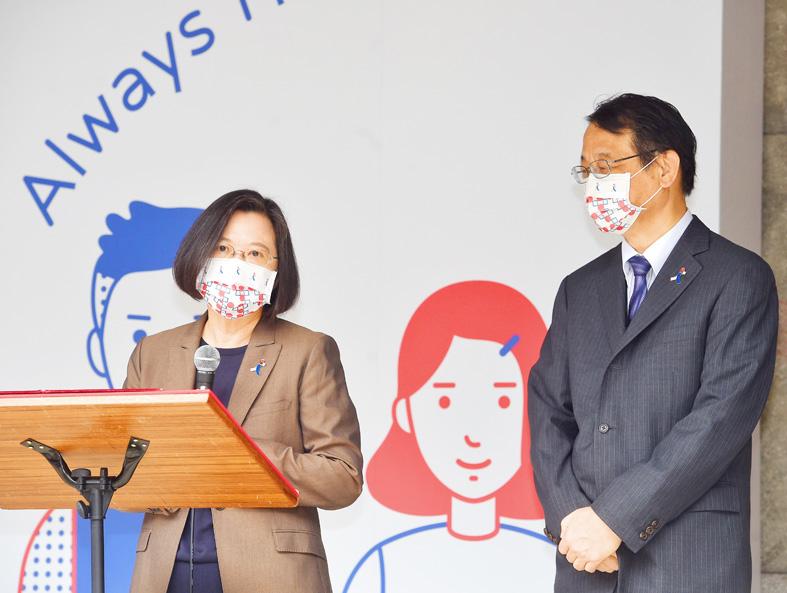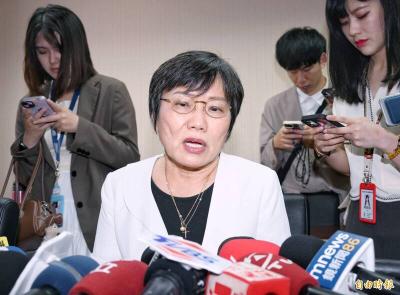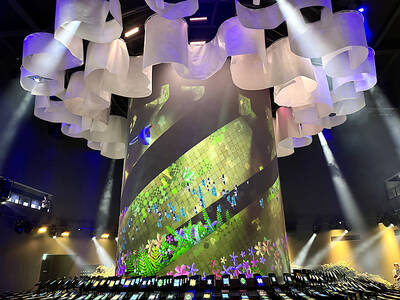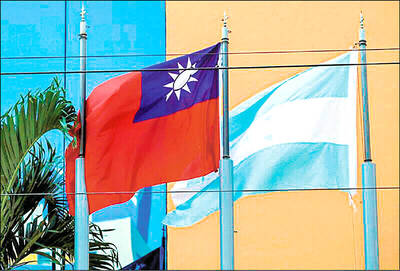President Tsai Ing-wen (蔡英文) yesterday slammed a referendum to activate the mothballed Fourth Nuclear Power Plant, citing the lack of a long-term storage facility for spent fuel rods.
The referendum to activate the plant in New Taipei City’s Gongliao District (貢寮) is scheduled for Aug. 28, while another referendum proposal to move a proposed liquified natural gas (LNG) terminal off the coast of Taoyuan is also expected to clear the threshold to be held.
Tsai made the remark at an event in Taipei yesterday marking Taiwanese-Japanese friendship in the wake of the 2011 Tohoku earthquake and tsunami.

Photo: Liu Hsin-de, Taipei Times
The ruling and opposition parties had for many years debated the merits of starting operation of the power plant, but all have come to accept that no local government is willing to host a storage facility for spent fuel rods, she said.
Concerns over safety and cost of nuclear energy make operating the plant not viable, Tsai said.
“We will accelerate the transformation of energy generation, and give Taiwan a safe and stable power supply,” she said.
The government has proposed that after the suspension of nuclear power generation in 2025, 50 percent of Taiwan’s energy should come from natural gas generators, 30 percent from coal-fired units and 20 percent from renewable sources. According to Taiwan Power Co data for last year, 12.7 percent of the nation’s energy comes from nuclear power, 78.5 percent from coal, 5.8 percent from renewables, and the rest from other sources.
Taiwan has four nuclear power plants. The Jinshan Nuclear Power Plant, the Guosheng Nuclear Power Plant and the mothballed Fourth Nuclear Power Plant are in New Taipei City, while the Ma-anshan Nuclear Power Plant is in Pingtung County.
When asked whether he would support the referendum to start the Fourth Nuclear Power Plant, New Taipei City Mayor Hou You-yi (侯友宜) on Wednesday reiterated that New Taipei City does not want to house a facility for spent fuel rods in addition to the plant.
“My position on the issue has been consistent. We cannot make use of nuclear power if we do not have facilities for radioactive waste,” Hou said. “Nuclear waste disposal is the biggest problem of New Taipei City.”
While the central government has started work to decommission the more than 40-year-old Jinshan and Guosheng power plants, it has never told New Taipei City residents if spent fuel rods would remain in the city, he said.
Meanwhile, the Presidential Office responded to a local media report accusing Vice President William Lai (賴清德) that he had pushed through an environmental impact assessment for the LNG terminal project without due dilligence.
The Chinese-language Web site the Journalist (新新聞) reported that Lai had angered environmental groups after the government had to shelve a project to expand the coal-fired Shenao power plant in New Taipei City’s Ruifang District (瑞芳), citing an annamed senior government official.
Presidential Office spokesman Xavier Chang (張惇涵) said that the report was based on a single unnamed source, as well as political speculation and exaggeration.
“All policy decisions were made after all involved departments and ministries were consulted,” he said. “The environmental impact assessment has been conducted as stipulated by law.”

Chinese Nationalist Party (KMT) Chairman Eric Chu (朱立倫), spokeswoman Yang Chih-yu (楊智伃) and Legislator Hsieh Lung-chieh (謝龍介) would be summoned by police for questioning for leading an illegal assembly on Thursday evening last week, Minister of the Interior Liu Shyh-fang (劉世芳) said today. The three KMT officials led an assembly outside the Taipei City Prosecutors’ Office, a restricted area where public assembly is not allowed, protesting the questioning of several KMT staff and searches of KMT headquarters and offices in a recall petition forgery case. Chu, Yang and Hsieh are all suspected of contravening the Assembly and Parade Act (集會遊行法) by holding

PRAISE: Japanese visitor Takashi Kubota said the Taiwanese temple architecture images showcased in the AI Art Gallery were the most impressive displays he saw Taiwan does not have an official pavilion at the World Expo in Osaka, Japan, because of its diplomatic predicament, but the government-backed Tech World pavilion is drawing interest with its unique recreations of works by Taiwanese artists. The pavilion features an artificial intelligence (AI)-based art gallery showcasing works of famous Taiwanese artists from the Japanese colonial period using innovative technologies. Among its main simulated displays are Eastern gouache paintings by Chen Chin (陳進), Lin Yu-shan (林玉山) and Kuo Hsueh-hu (郭雪湖), who were the three young Taiwanese painters selected for the East Asian Painting exhibition in 1927. Gouache is a water-based

Taiwan would welcome the return of Honduras as a diplomatic ally if its next president decides to make such a move, Minister of Foreign Affairs Lin Chia-lung (林佳龍) said yesterday. “Of course, we would welcome Honduras if they want to restore diplomatic ties with Taiwan after their elections,” Lin said at a meeting of the legislature’s Foreign Affairs and National Defense Committee, when asked to comment on statements made by two of the three Honduran presidential candidates during the presidential campaign in the Central American country. Taiwan is paying close attention to the region as a whole in the wake of a

OFF-TARGET: More than 30,000 participants were expected to take part in the Games next month, but only 6,550 foreign and 19,400 Taiwanese athletes have registered Taipei city councilors yesterday blasted the organizers of next month’s World Masters Games over sudden timetable and venue changes, which they said have caused thousands of participants to back out of the international sporting event, among other organizational issues. They also cited visa delays and political interference by China as reasons many foreign athletes are requesting refunds for the event, to be held from May 17 to 30. Jointly organized by the Taipei and New Taipei City governments, the games have been rocked by numerous controversies since preparations began in 2020. Taipei City Councilor Lin Yen-feng (林延鳳) said yesterday that new measures by